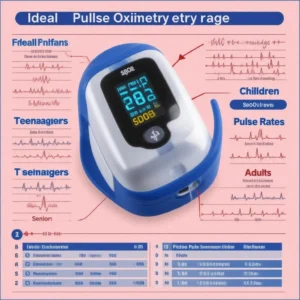Ideal Pulse Oximetry Rates by Age: A Detailed Breakdown
Pulse oximetry is a simple, non-invasive way to measure how well oxygen is being delivered to your body. Whether you’re monitoring your health at home or in a clinical setting, understanding what is a good pulse ox rate by age is crucial. This article will provide a detailed breakdown of ideal pulse oximetry rates by age, explain why they matter, and offer actionable tips for maintaining healthy oxygen levels.
What Is Pulse Oximetry and Why Does It Matter?
Pulse oximetry measures two key metrics:
- Oxygen Saturation (SpO2): The percentage of oxygen in your blood.
- Pulse Rate: The number of heartbeats per minute.
These metrics are vital because they provide insights into your respiratory and cardiovascular health. Low oxygen levels (hypoxemia) or abnormal pulse rates can indicate underlying health issues, such as lung disease, heart conditions, or infections like COVID-19.
What is a good pulse ox rate by age? Generally, a healthy SpO2 level ranges between 95% and 100%, while a normal pulse rate varies by age group. Let’s dive deeper into these numbers.
Ideal Pulse Oximetry Rates by Age
1. Infants and Toddlers (0-2 Years)
- SpO2: 95%-100%
- Pulse Rate: 100-160 bpm (beats per minute)
Infants and toddlers have higher heart rates due to their rapid growth and development. A pulse oximeter can help monitor their oxygen levels, especially if they have respiratory conditions like bronchiolitis or congenital heart defects.
Key Tips:
- Ensure the pulse oximeter fits properly on their tiny fingers or toes.
- Consult a pediatrician if SpO2 levels consistently fall below 95%.
2. Children (3-12 Years)
- SpO2: 95%-100%
- Pulse Rate: 70-120 bpm
Children in this age group typically have lower heart rates than infants but higher than adults. Pulse oximetry is particularly useful for children with asthma or other chronic respiratory conditions.
Key Tips:
- Encourage physical activity to promote healthy oxygen levels.
- Monitor SpO2 levels during illness or after strenuous exercise.
3. Teenagers (13-18 Years)
- SpO2: 95%-100%
- Pulse Rate: 60-100 bpm
Teenagers’ pulse rates begin to align with adult norms. However, factors like stress, anxiety, or sports injuries can affect their readings.
Key Tips:
- Educate teens on the importance of monitoring their health.
- Use pulse oximeters during sports or high-altitude activities.
4. Adults (19-65 Years)
- SpO2: 95%-100%
- Pulse Rate: 60-100 bpm
For adults, maintaining a SpO2 level above 95% is ideal. A pulse rate outside the 60-100 bpm range may indicate arrhythmia or other cardiovascular issues.
Key Tips:
- Regularly check your SpO2 levels if you have chronic conditions like COPD or sleep apnea.
- Stay hydrated and avoid smoking to maintain healthy oxygen levels.
5. Seniors (65+ Years)
- SpO2: 93%-100%
- Pulse Rate: 60-100 bpm
Older adults may have slightly lower SpO2 levels due to age-related changes in lung function. However, levels below 93% should be evaluated by a healthcare professional.
Key Tips:
- Use a pulse oximeter to monitor oxygen levels during sleep or physical activity.
- Seek medical advice if you experience shortness of breath or dizziness.
Factors That Affect Pulse Oximetry Readings
Several factors can influence your SpO2 and pulse rate, including:
- Altitude: Higher altitudes can lower oxygen levels.
- Activity Level: Exercise temporarily increases heart rate and oxygen demand.
- Health Conditions: Chronic illnesses like asthma, COPD, or anemia can affect readings.
- Smoking: Reduces oxygen-carrying capacity in the blood.
For more information on how these factors impact your health, check out our article on what is the normal range for oximeter.
How to Use a Pulse Oximeter Correctly
To get accurate readings, follow these steps:
- Place the oximeter on your index or middle finger.
- Ensure your hand is warm and relaxed.
- Sit still and avoid talking during the measurement.
- Wait 10-15 seconds for the reading to stabilize.
For a detailed guide on choosing the right device, read our article on what is the highest-rated oximeter.
When to Seek Medical Attention
Consult a healthcare provider if:
- Your SpO2 level consistently falls below 90%.
- Your pulse rate is consistently above 100 bpm (tachycardia) or below 60 bpm (bradycardia).
- You experience symptoms like chest pain, shortness of breath, or confusion.
For more insights, explore our article on what happens when your oxygen level drops to 70.
FAQs About Pulse Oximetry
1. What is a normal heart rate on an oximeter?
A normal heart rate ranges from 60-100 bpm for adults. For more details, visit what is a normal heart rate on an oximeter.
2. Can an oximeter detect blood pressure?
No, pulse oximeters measure oxygen levels and heart rate, not blood pressure. Learn more in our article can an oximeter detect blood pressure.
3. Which finger is best for pulse oximetry?
The index or middle finger typically provides the most accurate readings. For tips, read which finger oximeter is most accurate.
Conclusion
Understanding what is a good pulse ox rate by age is essential for maintaining optimal health. By monitoring your SpO2 and pulse rate, you can detect potential issues early and take proactive steps to improve your well-being.
If you have further questions or need personalized advice, don’t hesitate to contact us or reach out via WhatsApp. Your health is our priority!

